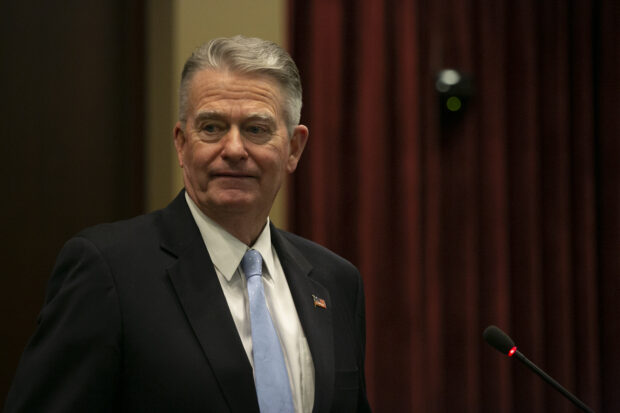
Gov. Brad Little hopes the Legislature will foot the bills for one-time teacher bonuses, workforce development training and grants for families using federal dollars passed onto Idaho through the American Rescue Plan Act (ARPA), the latest round of congressional coronavirus relief.
Little’s budget director Alex Adams on Wednesday ran the Legislature’s House-Senate budget committee through the pitch, shedding light on how the governor would bankroll a laundry list of education items that Little floated Monday.
Little’s asks, by the numbers:
- $1,000 bonuses for public school teachers this fiscal year, which ends June 30, with a $17.8 million price tag.
- Accelerating teachers’ moves up the state pay ladder, granting $104 million in raises. Little wants a $36.5 million chunk of that to come from federal money, and the rest to be paid out of state coffers.
- A temporary $50 million “Empowering Parents Grants” program, designed to help cover family education expenses.
- $50 million for workforce development training.
- $1.3 million for remote worker training.
Avoiding a funding cliff: ARPA money will eventually run out, and the state’s $1.1 billion must be spent by 2026. So, the programs Idaho chooses to fund with one-time money should generally be used to cover one-time costs, Adams said. Otherwise, recurring expenses and permanent programs will have to be covered by state money in future years or cut.
Little’s proposal to lawmakers, consequently, is that those federally funded education proposals should be one-off programs and spending increases. That’s the case for the bonuses, trainings and grants he’s pushing, for instance.
Stacking money for schools: Idaho K-12 schools have already received some $440 million from ARPA. The governor’s proposal to rudder $54 million of state-controlled ARPA money to school staff — about 5% of the so-called State Fiscal Recovery Fund — will add to that total, but with a different goal.
The money will help in “ensuring that teacher pay is fair and competitive,” and aid schools in retaining teachers in a job market tightened by inflation, Adams told the Legislature’s budget-writing committee.
Most school districts and charters plan to add or sustain staff positions with their federal money, but a minority plan to provide bonuses and financial incentives geared at staff retention, an EdNews analysis found.
Feds open another door for education: The U.S. Department of the Treasury expanded its list of approved uses for ARPA money Friday, clarifying that state and local governments can use their funds to top schools’ planned investments with more spending on early education and addressing learning loss. That could give the Legislature even wider latitude to funnel federal money into schools moving forward.
A note on teacher raises: Of the $104 million Little proposed for the career ladder, $41.6 million would cover the Legislature’s preexisting obligation to pay out raises to teachers based on experience, in accordance with state law, Division of Financial Management Analyst Gideon Tolman told EdNews by email Wednesday. Otherwise put, a majority of that $104 million — but not all of it — will be used to get educators raises earlier than expected.
Ybarra, SDE staff discuss pandemic responses, and prospects
Two years into the pandemic, school administrators have pivoted from trying to ride out the coronavirus to trying to remain open, state superintendent Sherri Ybarra said Wednesday.
Because school leaders are figuring out the pandemic, nearly every school in Idaho is open and operating, Ybarra told the House Education Committee. But that might change, as coronavirus cases surge once again.
“We’re starting to see some short-term closure, maybe a day here or two days there,” Ybarra said.
Ybarra came to Wednesday’s hearing armed with an 88-page PowerPoint presentation and flanked by more than a dozen State Department of Education administrators, who walked House Education members through SDE’s response to the pandemic.
In school nutrition, the state used federal coronavirus relief money to bolster its federally funded programs, and will soon use a $5.3 million federal grant to address supply chain issues. Compared to the beginning of the pandemic, schools might not deliver as many breakfasts and lunches to remote-learning students, child nutrition director Colleen Fillmore said. “But if (case) numbers really start going up again, I can see some of that happening.”
Schools spent the vast majority of the $136 million earmarked from the first federal coronavirus stimulus law, the 2020 Coronavirus Aid, Relief, and Economic Security Act. Schools returned just $400,000 of this money, federal programs director Karen Seay.
The SDE will now help schools use the rest of the coronavirus aid: $642 million, which must be spent by September 2024. While this money comes with extensive federal reporting requirements attached to it, Seay reminded House Education members that schools have wide latitude. They can essentially spend the money to address any issue caused, or exacerbated, by the pandemic.
Wednesday marked House Education’s first full meeting of the 2022 session, and Ybarra’s first appearance before lawmakers this session. Ybarra will present her K-12 budget request to the Joint Finance-Appropriations Committee Monday.
